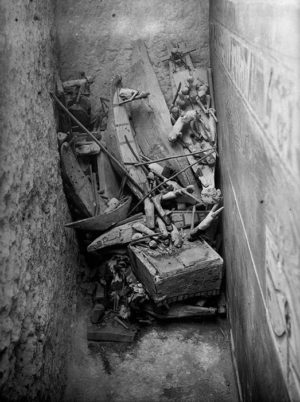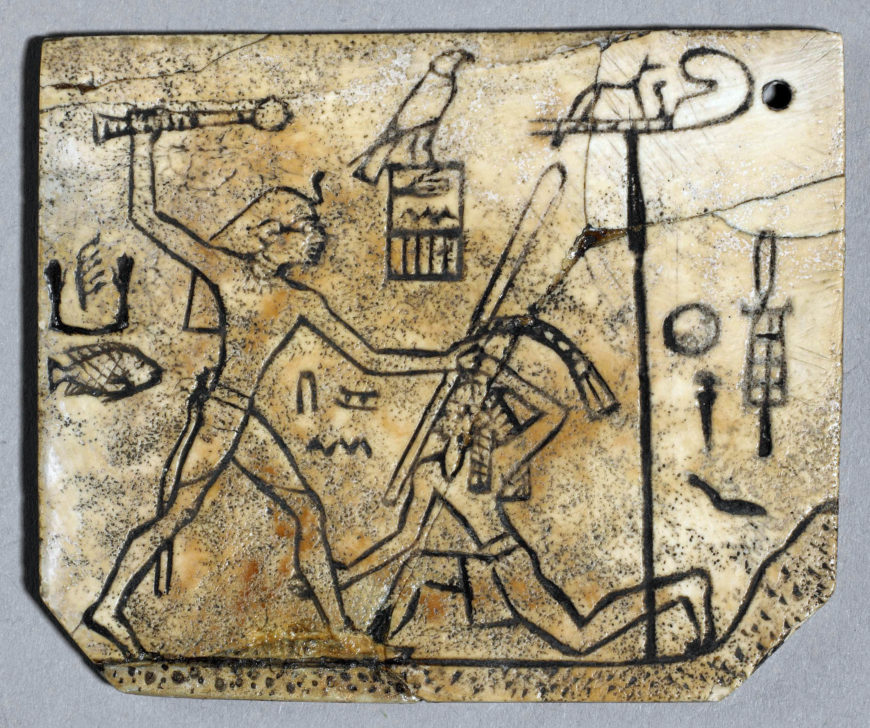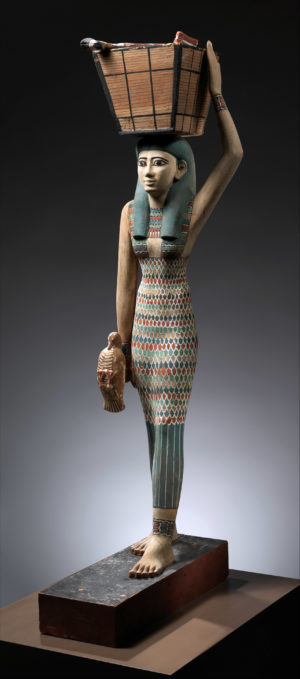The ancient Egyptian desire to craft an ideal afterlife led to a later (incorrect) perception that they were obsessed with death. Far from it! Instead, in equipping their tombs as thoroughly as possible, each Egyptian was focused on preparing for their ongoing existence in the next life. From early in its history, Egyptian tombs generally had two primary elements:
- an accessible, above-ground chapel or shrine where visitors could come perform rituals and leave offerings and
- a hidden, sealed, subterranean chamber containing the mummy, daily life items, food, and other grave goods, as well as texts and spells designed to aid the deceased on their journey through the netherworld.
There was significant innovation and change over time in the contents of these burial assemblages, but the need to preserve the body and provide for daily needs in the afterlife remained essential.
Private tombs
Predynastic (c. 5000–3000 B.C.E.) and Early Dynastic periods (c. 3000–2686 B.C.E.)
The earliest burials (up through the late Predynastic Period) consisted of a simple shallow pit with the body, surrounded by pots, tools, and other daily life items, being placed directly in contact with the dry sand and covered over. This practice often resulted in natural mummies, where the arid environment has desiccated and preserved the bodies, sometimes in surprisingly excellent condition.

Tomb 100, mural painting showing people engaging in a variety of activities along the Nile River (watercolor copy), c. 3200 B.C.E., predynastic period, Hierakonpolis, Egypt (in F. W. Green and James E. Quibell, Hierakonpolis (Band 2) (London, 1902)
The first properly constructed tombs, commonly brick-lined pits with plastered walls, appeared in Egypt shortly before the time of political unification (around 3100 B.C.E.). This basic type developed into a more complex subterranean structure by the First and Second Dynasty royal burials at Abydos, likely intended to evoke a palace for the afterlife.
While kings were buried in the south during this early period, many nobles were instead buried at Saqqara in the north near the newly established national capital of Memphis. Their large tombs included an impressive rectangular superstructure with niched walls atop a burial chamber dug into the bedrock and roofed with wood. The superstructures included multiple chambers that would have been filled with funerary goods.
Old Kingdom c. 2686–2150 B.C.E.

Drawing of Vizier Ptah-Wash’s mastaba, from Vesiren Ptah-wash’ sjæledør og hans sørgelige skæbne by Elin Rand Nielsen, vol. I: Nationalmuseets arbejdsmark (Nationalmuseet : Poul Kristensens Forlag, 1993; CC0)
Once the royal burials moved north to Saqqara starting in Dynasty Three, elites tended to be buried in large cemeteries that surrounded the tombs of their kings. In the Old Kingdom, these private tombs took the form of a bench-shaped mastaba (a flat, rectangular tomb form) that sat atop the burial chamber. Interment was achieved via a shaft from the top of the mastaba that was then filled in, making it inaccessible. Access was instead provided via a cut into the side of the mastaba that led to a stone-lined chapel that housed statues of the deceased sealed within the walls and included a stela known as a false door, which was believed to act as a portal, for the spirit to use, between the realms of the living and the dead. Walls were usually covered with lively, idealized scenes of daily life, representations of the deceased’s achievements, and vignettes of the venerated dead seated before overflowing tables of food. These chapels were for mortuary cult practices, encouraging the performance of rituals and the leaving of offerings intended to benefit the deceased.
First Intermediate Period (c. 2150–2030 B.C.E.) and Middle Kingdom (c. 2030–1640 B.C.E.)
During the First Intermediate Period and Middle Kingdom, the rock-cut chapels of some elite tombs depict scenes of the deceased presiding over religious festivals and venerating cult objects—types of activity that would not have been permitted in private tombs of the Old Kingdom.

Model scene of workers ploughing a field, Middle Kingdom, 2010–1961 B.C.E., wood, 54 cm (MFA Boston)
‘Daily life’ scenes continue to appear as well, both on the walls and in the form of wooden models.

Painted wooden inner-coffin of Seni with lid, c. 1850 B.C.E. (12th dynasty), painted wood, findspot: Deir el-Bersha, Egypt (© The Trustees of the British Museum)
Coffins from elite burials were often extensively painted with texts and scenes intended to aid the deceased in the afterlife. This collection of funerary literature is now referred to as the Coffin Texts.
New Kingdom (c. 1550–1070 B.C.E.) and Third Intermediate Period (c. 1070–713 B.C.E.)

Nebamun fowling in the marshes, Tomb-chapel of Nebamun, c. 1350 B.C.E., 18th Dynasty, paint on plaster, 83 x 98 cm, Thebes © Trustees of the British Museum
Elite tombs in the New Kingdom continued to include elaborately decorated rock-cut chapels for the family to visit and offer ongoing sustenance for the dead; there were even special cyclical festivals focused on these visits. Chapels were often beautifully decorated with painted scenes related to important events from the life of the deceased and ritual scenes designed to provide for them in the afterlife. Some preserved scenes included lively and vibrant representations of their life on earth.
Thebes remained the primary cemetery for New Kingdom elites until the Twentieth Dynasty when the capital moved to the north-east part of the Delta. Tombs constructed in the north were quite different, being placed within or near temple precincts and incorporating brick-vaulted chambers. Further changes in burial practices are apparent in the Third Intermediate Period, particularly a more intense focus on the mummy and its coffin and and increase of family or group crypts.
Late Period (c. 713–332 B.C.E.)
After the reunification of the Twenty-fifth Dynasty and through the Twenty-sixth, monumental private tombs reappeared briefly again both at Thebes and in the north. Some of the most massive rock-cut tombs ever discovered in Egypt are private tombs constructed at Thebes during the Twenty-sixth Dynasty. At Saqqara, burials were placed at the bottom of immense shafts dug into the bedrock that would have been completely filled with sand and rubble to seal the sepulcher; a number of these survived intact into the modern era.
Ptolemaic Period (c. 332–30 B.C.E.) and Roman Period (c. 30 B.C.E.–395 C.E.)

Anthropomorphic Anubis, burial chamber of the main tomb, Kom el-Shoqafa, Alexandria, Egypt (photo: Marjorie Susan Venit)
During the Ptolemaic Period, group burials continued and (not surprisingly) there was a marked increase in Hellenistic elements in the iconography given the Macedonian origins of the ruling family in this era. Simultaneously, understanding of the traditional Egyptian funerary imagery begins to erode and a fascinating blend of representational styles develops. Particularly in Alexandria, the blurring of the divide between indigenous Egyptian traditions and Hellenistic cultural approaches creates something of a hybrid between the two.
We see more rounded bodies in relief depictions and Greek-style dress and hairstyle on the mummy portraits of this period. Even old Egyptian deities like Anubis appear with a Hellenistic-style body and Roman armor in the 2nd century Alexandrian catacombs of Kom El Shoqafa.

Mummy of Herakleides, 120–140 C.E., Romano-Egyptian, human and bird remains, linen, pigment, beeswax, and wood (The Getty Villa)
This is even more apparent in the Roman era, with astonishingly individual portrait panels being placed over the face of the mummy. These startling, often elaborately-wrapped mummies appear to have then been kept on view in the family home or a public repository to receive offerings. After a period of time (presumably to make more room for the more recent dead), they were gathered, stacked atop each other, and interred in mass burial pits.

Figurines in a ransacked tomb chamber next to the coffin (right), Tomb of Djehutynakht (Barsha), Dynasty 12, from Museum of Fine Arts, Boston expedition in 1915.
Provisioning the Dead
From the earliest times, even simple burials included not only the body of the deceased but also items intended for use in the afterlife. Royal and non-royal burials were full of objects of all types—furniture, tools, personal care implements (like razors and stone palettes used to grind mineral makeup), foodstuffs, and clothing.

King Den’s sandal label, 1st dynasty, ivory, found at Abydos, Upper Egypt, 4.5 x 5.3 cm (© Trustees of the British Museum)
For example, an ivory label from the tomb of king Den has a ritual scene on one side and a simple depiction of sandals on the other, indicating the grave good they were originally attached to.

offering bearer, c. 1981–1975 B.C.E. (dynasty 12),
Middle Kingdom, wood, gesso, paint, from Egypt, Upper Egypt, Thebes, Southern Asasif, Tomb of Meketre (TT 280, MMA 1101), serdab, MMA excavations, 1920, 112 x 17 cm (The Metropolitan Museum of Art)
The ideal vision of the existence beyond that was the goal of all deceased Egyptians—a perfected, effortless version of the life they experienced when among the living. Scores of ‘support staff’ were often evident in the form of scenes of daily life that covered the walls or wooden models that provided produce and sustenance for the deceased. Many models and scenes show the preparation of various foodstuffs and other goods desired in the afterlife, or were shown bringing offerings. A particularly beautiful example of one of these offering models is a statue of an offering bearer from the Tomb of Meketre.

Ushabti for Neferibresaneith, about 570–526 B.C.E., Egyptian. Green faience, 7 3/16 × 2 1/16 inches (The J. Paul Getty Museum)
Beginning in the First Intermediate Period, the deceased was also accompanied by small figures that were intended to perform work on their behalf in the afterlife. Referred to as ushabtis, eventually there could be hundreds of these ‘afterlife workers’ provided to perform a wide range of tasks, along with images of overseers to manage them.
Well-equipped tomb often included a wide range of daily life items, including actual foodstuffs (like dried fruits, grain, honey, jars of beer or wine, and prepared meats), furniture (such as beds, chairs, and footstools), clothing (from headcloths to sandals, and everything between), games, and personal items (mirrors, cosmetics, perfumes, etc.).
In addition, tools particular to one’s profession would be included—officials were interred with scribal palettes, complete with reed pens and pots of ink, while soldiers had swords, chariots, and other weapons. The tomb was ideally provisioned not only to provide all the comforts of home for the deceased in the afterlife, but also to symbolically support their transition to an effective akh. For instance, cosmetic jars were often shaped in the form of a lotus flower, an emblem of regeneration that served a symbolic function in the tomb context in addition to the practical role as a container.
The best possible afterlife
The continued existence of the properly housed and well-provisioned body on earth was clearly considered important for an ideal afterlife from very early in Egypt’s history. Even before the initial political unification, the deceased were provided with the goods needed to support their next life. Burial practices developed over the millennia, shifting and evolving to accommodate changes while maintaining the underlying fundamental requirements: an identifiable, preserved body and a safe place for the mummy (and its provisions) to call home. This terrestrial anchor provided a conduit that allowed the deceased in the afterlife to benefit from those grave goods, foodstuffs, ritual actions, offerings, models, texts, spells and scenes and enjoy an eternal, perfected afterlife in the Field of Reeds. Given this belief, it’s not surprising that Egyptians invested as much as possible in provisioning their tombs and setting themselves up for the best afterlife they could afford.





